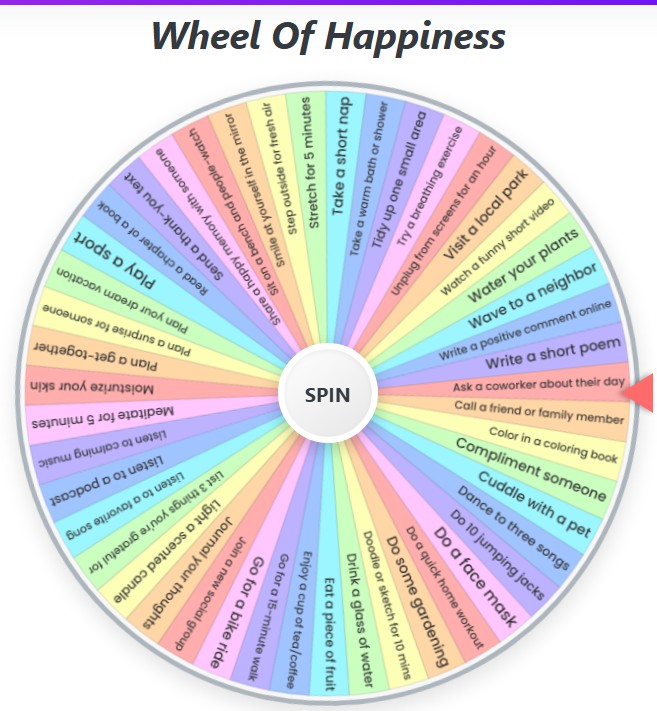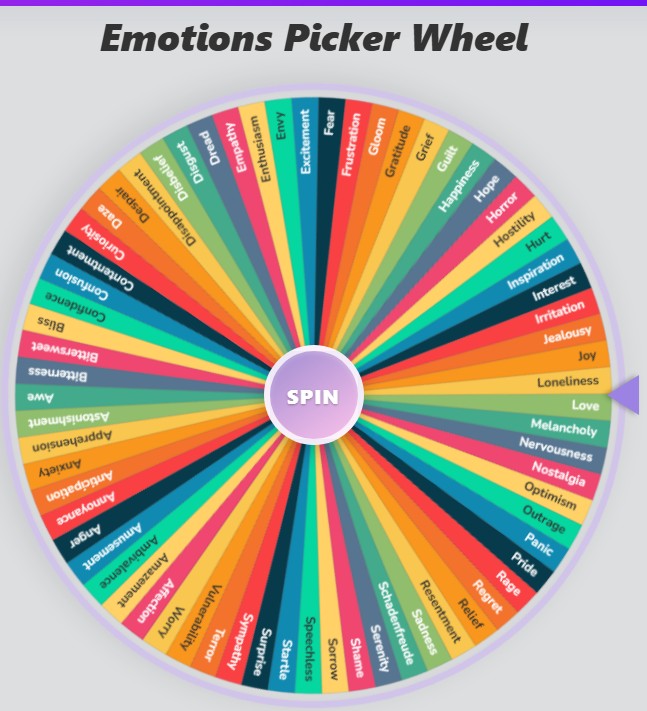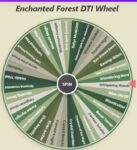Sad Emotion Wheel
Current Mode: None
Quick Link:
- Positive Emotions Wheel
- Zodiac Sign Wheel
- Yes or no wheel
- 70 Emotion Picker Wheel – Spin & Discover Feelings
- 60 Feelings Picker Wheel – Spin & Discover
- Rock, Paper, Scissors, Lizard, Spock – Full Game & Rules
The Ultimate Sad Emotion Wheel: A Guide to Understanding Your Feelings
Ever feel a wave of sadness but can’t quite put your finger on what it is? You know it’s more than just “sad,” but the right words escape you. Is it loneliness? A touch of despair? Maybe a flicker of insecurity? Navigating these complex emotions can be tough, but you’re not alone in this feeling. That’s where a tool like an interactive sad emotion wheel comes in.
Think of it as a compass for your heart 🧭. It helps you identify the specific shades and nuances of your feelings, turning a vague sense of unhappiness into something you can name, understand, and reflect upon. This guide will walk you through our powerful and intuitive sad feelings wheel, explaining every feature so you can use it to explore your inner world with clarity and kindness.
First, let’s dive straight into the core emotions this wheel helps you explore.
Explore the Core Sad Emotions
Our wheel is organized into distinct categories to help you narrow down your feelings. Here are the emotions you’ll find within each category.
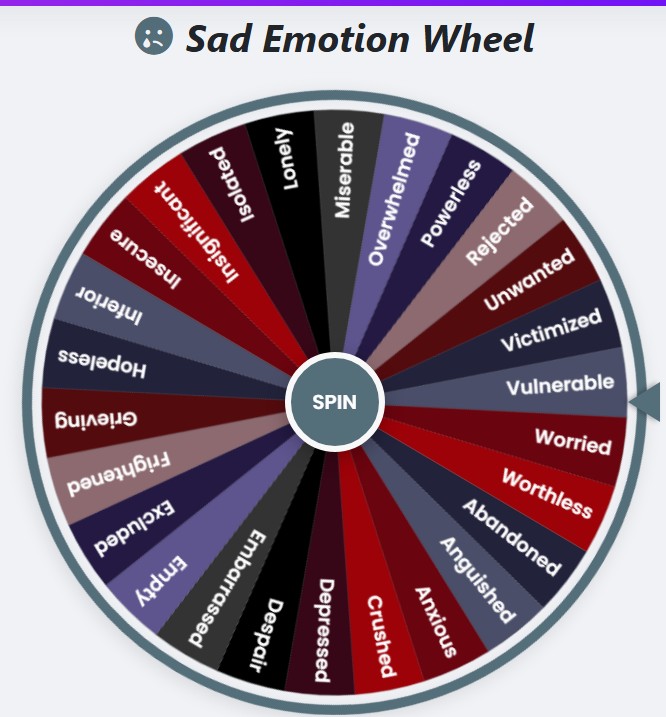
Loneliness
- Isolated
- Abandoned
- Victimized
- Lonely
- Empty
- Unwanted
- Excluded
- Rejected
Despair
- Grieving
- Powerless
- Vulnerable
- Despair
- Anguished
- Miserable
- Hopeless
- Depressed
- Crushed
Insecurity
- Insecure
- Anxious
- Worried
- Overwhelmed
- Frightened
- Inferior
- Worthless
- Insignificant
- Embarrassed
All Sad Emotions
This category combines all the emotions from Loneliness, Despair, and Insecurity into one comprehensive wheel for a broader exploration. It includes every single feeling listed above, giving you the complete landscape of emotions to spin through.
Getting Started with the Wheel
Now that you’re familiar with the emotional landscape, let’s get you spinning! Using the sad emotion wheel is designed to be a simple and reflective process.
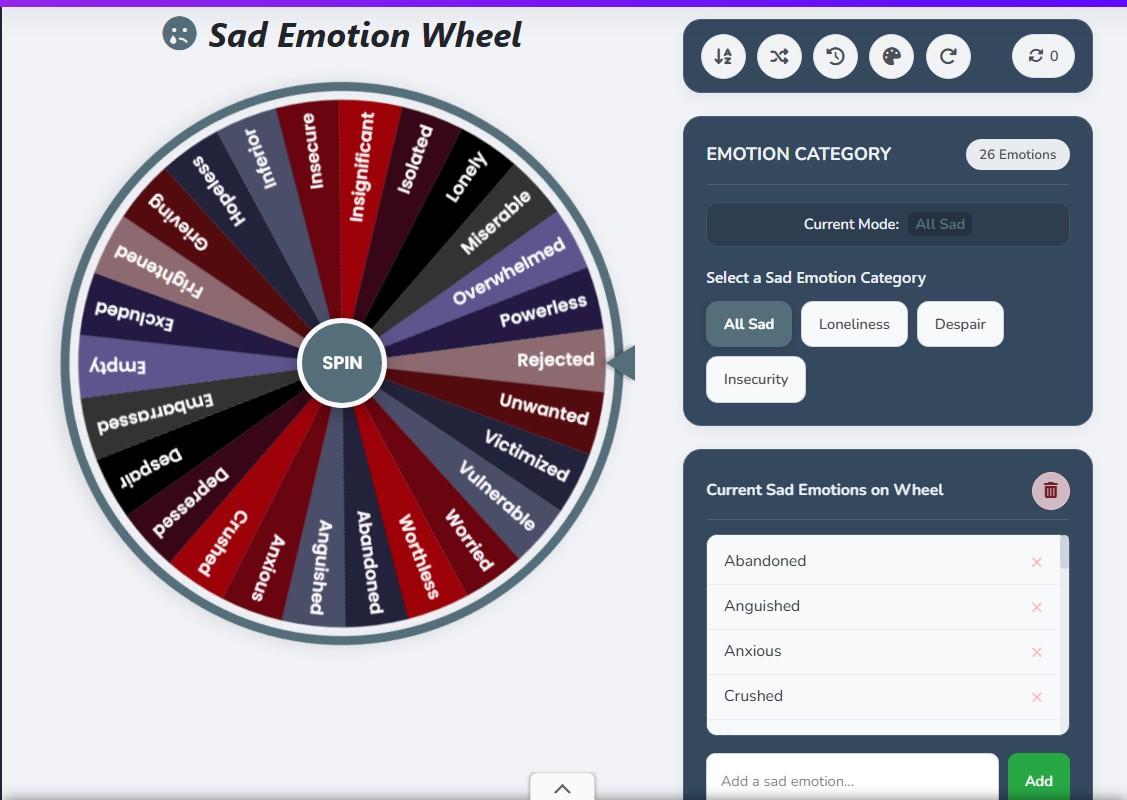
Your First Spin
The main event is the wheel itself! It’s front and center, waiting for you. To get started, simply find the big “SPIN” button at its heart. When you click it, the wheel will whirl to life with a satisfying sound before landing on a single emotion. This result isn’t a diagnosis; it’s a gentle suggestion—a starting point for your thoughts. What does that word mean to you right now? Does it resonate? The goal is simply to notice.
Selecting an Emotion Category
Just below the wheel, you’ll find the control center. The first thing you’ll likely want to do is choose which feelings appear on the wheel. This is done through the “Emotion Category” section. You’ll see buttons for “Loneliness,” “Despair,” “Insecurity,” and “All Sad.”
Clicking on any of these categories instantly updates the sad feelings wheel with the corresponding emotions. For instance, if you’re feeling a sense of disconnect from others, you might click “Loneliness.” The wheel will then be populated only with emotions related to that theme, like “Isolated,” “Abandoned,” and “Rejected.” This helps you focus your reflection on a specific area of your sadness.
Mastering the Controls
Beyond just spinning, the tool offers a suite of controls to help you tailor the experience. These are found in the “Action Buttons” panel and the item list.
The Main Action Buttons
This row of icons gives you quick access to powerful functions:
- Sort (A-Z) 🔠: Feeling a need for order? Clicking this button instantly arranges the emotions currently on the wheel in alphabetical order. This is perfect if you want a more structured view rather than a random arrangement.
- Shuffle 🔀: Want to mix things up? The Shuffle button randomizes the order of the emotions on the wheel. It’s a great way to break out of patterns and see the feelings in a new light before you spin.
- History 📜: Curious about your past spins? The History button opens a log of every emotion you’ve landed on during your session. This can be incredibly insightful for recognizing patterns or recurring feelings over time.
- Color Settings 🎨: While the emotions might be somber, your wheel doesn’t have to be! This button opens the palette settings, allowing you to change the color scheme of the wheel segments. You can choose from various themes, like “Gothic,” “Ocean,” or “Earthy,” to match your mood or aesthetic preference.
- Reset All 🔄: Need a completely fresh start? The Reset button is your go-to. It clears your spin history, resets the spin counter, removes any custom emotions, and returns the wheel to its original “All Sad” state.
The Spin Counter
To the right of the action buttons, you’ll see a small counter with a sync icon. This simply tracks how many times you’ve spun the wheel in your current session. It’s a small but helpful metric for seeing how much you’ve engaged with the tool.
Customizing Your Experience
This sad emotion wheel is not a static tool. It’s designed to be deeply personal, and that means you have full control over the emotions that appear on it.
Create Your Own Sad Feelings Wheel
Sometimes, the pre-listed words might not perfectly capture what you’re feeling. That’s why we included a custom input field. Below the list of emotions, you’ll see a box that says, “Add a sad emotion…”
Simply type in a word that resonates with you—perhaps “Disconnected,” “Unseen,” or “Stagnant”—and click “Add.” Your custom emotion will immediately be added to the wheel. The moment you add your first custom emotion, the tool switches to “Custom Mode.” This means you are now building your very own, personalized sad feelings wheel.
Editing and Removing Emotions
Your control doesn’t stop at adding. You can also edit and remove emotions directly from the list.
- To Edit: Simply click on the name of any emotion in the list. The text becomes editable. You can change “Worthless” to “Not Good Enough” or tweak any word to better fit your experience.
- To Remove: Next to each emotion is a small ‘×’ button. If a particular word doesn’t feel right or you want to simplify the wheel, just click the ‘×’ to remove it. You can even clear the entire wheel by clicking the trash can icon at the top of the list, allowing you to build a new one from scratch.
Understanding the Spin Results
The moment after the spin is where the real reflection begins. A pop-up window will appear to make sure you see the result clearly.
What Happens After the Spin?
The modal window will display the chosen emotion in large, clear text. From here, you have a few options:
- Eliminate Result: This is one of the most powerful features for self-exploration. More on this below!
- Spin Again: If the result didn’t resonate or you want to continue exploring, this button closes the window and lets you immediately spin the wheel again.
- OK: This simply closes the window, allowing you to sit with the result or interact with the controls.
The Power of Elimination
Let’s say the wheel lands on “Anxious,” but you feel that’s not quite it, though it’s close. The “Eliminate Result” button lets you remove “Anxious” from the wheel for subsequent spins.
This creates a process of elimination. You can spin, consider the emotion, and if it’s not the right fit, eliminate it and spin again. By doing this repeatedly, you narrow down the possibilities, getting closer and closer to the word that truly captures your current state. It transforms the sad emotion wheel from a game of chance into a methodical tool for discovery.
Why Use a Sad Emotion Wheel?
Beyond being an interactive tool, engaging with a sad feelings wheel offers several psychological benefits. It’s an exercise in mindfulness and emotional literacy.
Building Emotional Vocabulary
Often, we get stuck using just a few words to describe a vast range of feelings. This tool introduces you to a richer emotional vocabulary. Learning to distinguish between feeling “Powerless” and feeling “Vulnerable,” or between “Isolated” and “Rejected,” gives you a more precise language to understand yourself and communicate your needs to others.
A Moment for Mindfulness
The simple act of pausing your day to spin a wheel and consider an emotion is a mindfulness practice. It pulls you out of the chaotic stream of thoughts and into the present moment. It asks you one simple question: “How am I feeling right now?” This pause can be incredibly grounding, especially when you’re feeling overwhelmed.
A Starting Point for Reflection
The result of a spin is not an answer; it’s a question. If the wheel lands on “Grieving,” it prompts you to ask, “What might I be grieving?” If it lands on “Inferior,” it invites you to explore, “In what situations do I feel this way, and why?” It’s the perfect catalyst for journaling, meditation, or even a conversation with a friend or therapist.
Your feelings are valid, complex, and deserving of attention. The sad emotion wheel is here to be your companion on that journey of discovery. It offers no judgment, only a mirror to help you see yourself more clearly. So go ahead, give it a spin, and take a gentle step toward understanding the beautiful, intricate landscape of your own heart.
